Blog
What to Look for When Searching for Running Shoes
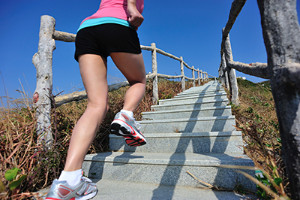 There are certain features that you should ensure your shoes have before you decide to start running. It is crucial that your shoe has arch support, cushioning, and traction in order to improve your running mechanics. The amount of support that you need in your shoe depends greatly on the arch of your foot. For example, people who have feet with high arches do not need shoes with a lot of support, since these may result in injury for them. It is important that you are aware of what type of foot arch you have so that you can find the perfect running shoe for you. Your podiatrist can help you evaluate your foot arch height as well as other factors that will help determine what running shoe you should purchase.
There are certain features that you should ensure your shoes have before you decide to start running. It is crucial that your shoe has arch support, cushioning, and traction in order to improve your running mechanics. The amount of support that you need in your shoe depends greatly on the arch of your foot. For example, people who have feet with high arches do not need shoes with a lot of support, since these may result in injury for them. It is important that you are aware of what type of foot arch you have so that you can find the perfect running shoe for you. Your podiatrist can help you evaluate your foot arch height as well as other factors that will help determine what running shoe you should purchase.
If you are a runner, wearing the right running shoe is essential. For more information, contact one of our podiatrists from Westside Podiatry Center, LLP. Our doctors can provide the care you need to keep you pain-free and on your feet.
Choosing the Right Running Shoe for Your Foot Type
To increase performance and avoid the risk of injury, it is important to choose the right running shoe based on your foot type. The general design of running shoes revolves around pronation, which is how the ankle rolls from outside to inside when the foot strikes the ground.
- Neutral runners are able to choose from a wide variety of shoes, including minimalist shoes or even going barefoot.
- Runners who overpronate, or experience an over-abundance of ankle rolling, should choose shoes that provide extra motion control and stability.
- Runners who underpronate, or supinate, have feet that have high arches and lack flexibility, preventing shock absorption. They require shoes with more flexibility and cushion.
If you have any questions please feel free to contact one of our offices located in Liverpool, Camillus, Skaneateles, Oswego, and Cicero, NY . We offer the newest diagnostic and treatment technologies for all your foot and ankle needs.
Children’s Heel Pain a sign of Sever’s Disease
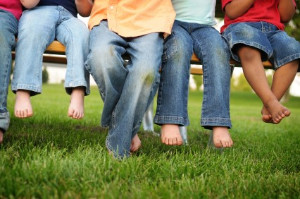 If your child is experiencing severe heel pain after participating in sports or other physical activities, this may be due to Sever’s disease. Sever’s disease, or calcaneal apophysitis, is an overuse injury that occurs in the growth plate of the heel bone. When children have growth spurts, the long bones grow rapidly in comparison to the muscles and tendons, which grow at a normal rate; this causes the muscles to tighten. Then, during physical activity, inflammation and pain can result. The most important thing your kids can do to ease their foot pain is to stretch properly and often. Pain can recur with growth spurts; regardless, be sure that your child continues stretching regularly while active.
If your child is experiencing severe heel pain after participating in sports or other physical activities, this may be due to Sever’s disease. Sever’s disease, or calcaneal apophysitis, is an overuse injury that occurs in the growth plate of the heel bone. When children have growth spurts, the long bones grow rapidly in comparison to the muscles and tendons, which grow at a normal rate; this causes the muscles to tighten. Then, during physical activity, inflammation and pain can result. The most important thing your kids can do to ease their foot pain is to stretch properly and often. Pain can recur with growth spurts; regardless, be sure that your child continues stretching regularly while active.
Sever's disease often occurs in children and teens. If your child is experiencing foot or ankle pain, see one of our podiatrists from Westside Podiatry Center, LLP. Our doctors can treat your child’s foot and ankle needs.
Sever’s Disease
Sever’s disease is also known as calcaneal apophysitis, which is a medical condition that causes heel pain I none or both feet. The disease is known to affect children between the ages of 8 and 14.
Sever’s disease occurs when part of the child’s heel known as the growth plate (calcaneal epiphysis) is attached to the Achilles tendon. This area can suffer injury when the muscles and tendons of the growing foot do not keep pace with bone growth. Therefore, the constant pain which one experiences at the back of the heel will make the child unable to put any weight on the heel. The child is then forced to walk on their toes.
Symptoms
Acute pain – Pain associated with Sever’s disease is usually felt in the heel when the child engages in physical activity such as walking, jumping and or running.
Highly active – Children who are very active are among the most susceptible in experiencing Sever’s disease, because of the stress and tension placed on their feet.
If you have any questions, please feel free to contact one of our offices located in Liverpool, Camillus, Skaneateles, Oswego, and Cicero, NY . We offer the newest diagnostic and treatment technologies for all your foot and ankle injuries.
Washington Wizards Guard Tears Achilles Tendon
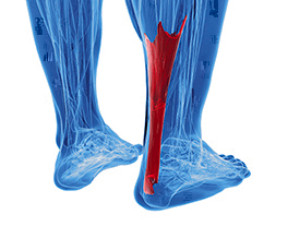 Basketball player Sheldon Mac of the Wizards has recently torn his left Achilles tendon and will need to undergo surgery to repair it. He will very likely be out for the rest of the season. His recovery timetable is around six to eight months. If there is any good news for Mac, it's that his contract guarantees him 1.3 million dollars. Of course, that doesn't really give much solace to the fans.
Basketball player Sheldon Mac of the Wizards has recently torn his left Achilles tendon and will need to undergo surgery to repair it. He will very likely be out for the rest of the season. His recovery timetable is around six to eight months. If there is any good news for Mac, it's that his contract guarantees him 1.3 million dollars. Of course, that doesn't really give much solace to the fans.
Achilles tendon injuries need immediate attention to avoid future complications. If you have any concerns, contact one of our podiatrists of Westside Podiatry Center, LLP. Our doctors can provide the care you need to keep you pain-free and on your feet.
What Is the Achilles Tendon?
The Achilles tendon is a tendon that connects the lower leg muscles and calf to the heel of the foot. It is the strongest tendon in the human body and is essential for making movement possible. Because this tendon is such an integral part of the body, any injuries to it can create immense difficulties and should immediately be presented to a doctor.
What Are the Symptoms of an Achilles Tendon Injury?
There are various types of injuries that can affect the Achilles tendon. The two most common injuries are Achilles tendinitis and ruptures of the tendon.
Achilles Tendinitis Symptoms
- Inflammation
- Dull to severe pain
- Increased blood flow to the tendon
- Thickening of the tendon
Rupture Symptoms
- Extreme pain and swelling in the foot
- Total immobility
Treatment and Prevention
Achilles tendon injuries are diagnosed by a thorough physical evaluation, which can include an MRI. Treatment involves rest, physical therapy, and in some cases, surgery. However, various preventative measures can be taken to avoid these injuries, such as:
- Thorough stretching of the tendon before and after exercise
- Strengthening exercises like calf raises, squats, leg curls, leg extensions, leg raises, lunges, and leg presses
If you have any questions please feel free to contact one of our offices located in Liverpool, Camillus, Skaneateles, Oswego, and Cicero, NY . We offer the newest diagnostic tools and technology to treat your foot and ankle needs.
Symptoms of Sesamoiditis
 If you experience pain between the ball of the foot and the big toe, you may have a condition referred to as sesamoiditis. It originates from the sesamoid bones, which can be found under the big toe. If the foot has a high arch, these tiny bones endure additional pressure while walking or running. The purpose of the sesamoid bones is to propel the foot forward while walking, which may become difficult to accomplish if they become injured. The symptoms typically consist of pain in the foot while walking, in addition to becoming red and swollen. Wearing a shoe with adequate padding will aid in attaining a certain amount of relief and may take a portion of the pressure off the sesamoid bones. Additional treatment techniques may consist of binding the big toe, which may limit movement, and utilizing crutches to keep the weight off the foot. Please schedule a consultation with a podiatrist if you would like additional information about sesamoiditis.
If you experience pain between the ball of the foot and the big toe, you may have a condition referred to as sesamoiditis. It originates from the sesamoid bones, which can be found under the big toe. If the foot has a high arch, these tiny bones endure additional pressure while walking or running. The purpose of the sesamoid bones is to propel the foot forward while walking, which may become difficult to accomplish if they become injured. The symptoms typically consist of pain in the foot while walking, in addition to becoming red and swollen. Wearing a shoe with adequate padding will aid in attaining a certain amount of relief and may take a portion of the pressure off the sesamoid bones. Additional treatment techniques may consist of binding the big toe, which may limit movement, and utilizing crutches to keep the weight off the foot. Please schedule a consultation with a podiatrist if you would like additional information about sesamoiditis.
Sesamoiditis is an unpleasant foot condition characterized by pain in the balls of the feet. If you think you’re struggling with sesamoiditis, contact one of our podiatrists of Westside Podiatry Center, LLP. Our doctors will treat your condition thoroughly and effectively.
Sesamoiditis
Sesamoiditis is a condition of the foot that affects the ball of the foot. It is more common in younger people than it is in older people. It can also occur with people who have begun a new exercise program, since their bodies are adjusting to the new physical regimen. Pain may also be caused by the inflammation of tendons surrounding the bones. It is important to seek treatment in its early stages because if you ignore the pain, this condition can lead to more serious problems such as severe irritation and bone fractures.
Causes of Sesamoiditis
- Sudden increase in activity
- Increase in physically strenuous movement without a proper warm up or build up
- Foot structure: those who have smaller, bonier feet or those with a high arch may be more susceptible
Treatment for sesamoiditis is non-invasive and simple. Doctors may recommend a strict rest period where the patient forgoes most physical activity. This will help give the patient time to heal their feet through limited activity. For serious cases, it is best to speak with your doctor to determine a treatment option that will help your specific needs.
If you have any questions please feel free to contact one of our offices located in Liverpool, Camillus, Skaneateles, Oswego, and Cicero, NY . We offer the newest diagnostic and treatment technologies for all your foot and ankle needs.
Myles Jack Ankle Injury
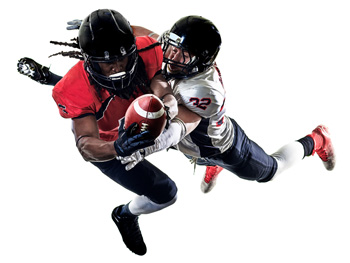 Jacksonville Jaguars’ Myles Jack recently injured his ankle while playing in the AFC championship game against the New England Patriots. After the linebacker hurt his ankle in a fumble recovery, the injury appeared to be serious as he was led to the locker room. Jack helped his team finish the game with six tackles, despite the Patriots winning the game 24-20. Jack will make his return to training camp in July while utilizing the entire offseason to recover.
Jacksonville Jaguars’ Myles Jack recently injured his ankle while playing in the AFC championship game against the New England Patriots. After the linebacker hurt his ankle in a fumble recovery, the injury appeared to be serious as he was led to the locker room. Jack helped his team finish the game with six tackles, despite the Patriots winning the game 24-20. Jack will make his return to training camp in July while utilizing the entire offseason to recover.
Sports related foot and ankle injuries require proper treatment before players can go back to their regular routines. For more information, contact one of our podiatrists of Westside Podiatry Center, LLP. Our doctors can provide the care you need to keep you pain-free and on your feet.
Sports Related Foot and Ankle Injuries
Foot and ankle injuries are a common occurrence when it comes to athletes of any sport. While many athletes dismiss the initial aches and pains, the truth is that ignoring potential foot and ankle injuries can lead to serious problems. As athletes continue to place pressure and strain the area further, a mild injury can turn into something as serious as a rupture and may lead to a permanent disability. There are many factors that contribute to sports related foot and ankle injuries, which include failure to warm up properly, not providing support or wearing bad footwear. Common injuries and conditions athletes face, including:
- Plantar Fasciitis
- Plantar Fasciosis
- Achilles Tendinitis
- Achilles Tendon Rupture
- Ankle Sprains
Sports related injuries are commonly treated using the RICE method. This includes rest, applying ice to the injured area, compression and elevating the ankle. More serious sprains and injuries may require surgery, which could include arthroscopic and reconstructive surgery. Rehabilitation and therapy may also be required in order to get any recovering athlete to become fully functional again. Any unusual aches and pains an athlete sustains must be evaluated by a licensed, reputable medical professional.
If you have any questions please feel free to contact one of our offices located in Liverpool, Camillus, Skaneateles, Oswego, and Cicero, NY . We offer the newest diagnostic and treatment technologies for all your foot and ankle needs.
Different Shoes for Various Styles of Running

There are several reasons why people choose to run. These include losing weight, training for a marathon, or jogging for pure enjoyment. There are different types of shoes for various styles of running, and it is beneficial to choose the type of shoe that fits comfortably, while enhancing the type of running that is desired. There are many factors that can determine what kind of shoes are purchased. These consist of weight, what type of surfaces are run on, and foot structure. Research has shown foot conditions may be avoided when properly fitting running shoes are worn. These include plantar fasciitis, ankle sprains, and general aches and pains in the foot and arch area. When the right shoes are worn, they are typically comfortable, and feel like they are part of the foot. Many people who enjoy running prefer to shop at a specialty store where they can get advice in matching their foot type to the appropriate shoe. There are different shoes that target a forefoot or heel striker, and it is important to know what type of running is done. If you would like additional information about how to purchase the correct running shoe, please confer with a podiatrist who can answer any questions you may have.
You should always make sure your running shoes fit properly in order to avoid injury. For more information, contact one of our podiatrists from Westside Podiatry Center, LLP. Our doctors can provide the care you need to keep you pain-free and on your feet.
Choosing the Right Running Shoe for Your Foot Type
Improper shoe sizing can cause a myriad of problems for your feet. Shoes that don’t fit you properly can lead to muscular imbalances in your body, which can result in foot, knee, and hip injuries.
Tips for Finding the Right Running Shoe
- Make sure you have a thumb’s width of wiggle room between the end of your longest toe and the front of the shoe.
- There should be little to no slipping at the heel
- Don’t assume your size in one shoe brand will be your size in another
- Do not lace up your shoes too tightly
- Walk around in the store with your new shoes before you buy them
If you have any questions please feel free to contact our one of our offices located in Liverpool, Camillus, Skaneateles, Oswego, and Cicero, NY . We offer the newest diagnostic and treatment technologies for all your foot and ankle needs.
Flat Feet and the Military
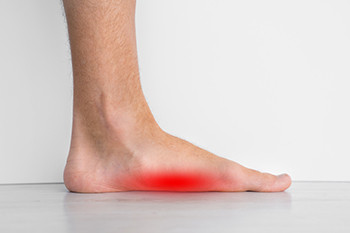
There are millions of people worldwide that are affected by flat feet. They can be a disqualifying condition for people who are interested in joining the military if the symptoms of flat feet are noticeable and present. Some symptoms can include pain in the arch or heel, and the ankles being swollen. Most babies are born with flat feet and the arch typically develops during the teenage years. People who never develop an arch may have no symptoms, or in the opposite case, symptoms may be obvious. These can consist of tiring easily, limited range of foot movement, and there may be a pain in the feet after walking or running. An effective method to determine if you have flat feet involves standing on your tiptoes and looking for an arch in the foot. Doing so may indicate a low arch or the arch may be nonexistent. Some patients perform foot exercises that help flat feet from being achy. If you would like to learn more about exercises and treatments for flat feet, please consult with a podiatrist.
Flatfoot is a condition many people suffer from. If you have flat feet, contact one of our podiatrists from Westside Podiatry Center, LLP. Our doctors will treat your foot and ankle needs.
What Are Flat Feet?
Flatfoot is a condition in which the arch of the foot is depressed and the sole of the foot is almost completely in contact with the ground. About 20-30% of the population generally has flat feet because their arches never formed during growth.
Conditions & Problems:
Having flat feet makes it difficult to run or walk because of the stress placed on the ankles.
Alignment – The general alignment of your legs can be disrupted, because the ankles move inward which can cause major discomfort.
Knees – If you have complications with your knees, flat feet can be a contributor to arthritis in that area.
Symptoms
- Pain around the heel or arch area
- Trouble standing on the tip toe
- Swelling around the inside of the ankle
- Flat look to one or both feet
- Having your shoes feel uneven when worn
Treatment
If you are experiencing pain and stress on the foot you may weaken the posterior tibial tendon, which runs around the inside of the ankle.
If you have any questions please feel free to contact one of our offices located in Liverpool, Camillus, Skaneateles, Oswego, and Cicero, NY . We offer the newest diagnostic and treatment technologies for all your foot and ankle needs.
Can Blisters Be Prevented While Hiking?
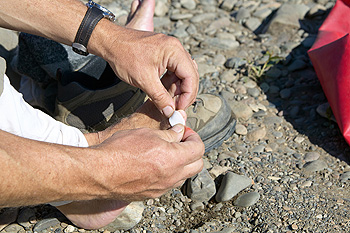 People who enjoy hiking often experience blisters on their feet. The most common cause of this ailment is excess friction, and this often occurs from wearing shoes and socks that do not fit correctly. Many hikers choose to wear boots, and it is helpful to break them in before beginning a hike. Wear the boots around your home or work with the socks you intend to hike with, and your feet will thank you later. Keeping the feet as dry as possible may also help in preventing blisters from developing. It is beneficial to pack extra socks, which can be swapped out immediately if the first pair becomes moist or wet. Please confer with a podiatrist if you would like additional tips on how to prevent blisters on the feet.
People who enjoy hiking often experience blisters on their feet. The most common cause of this ailment is excess friction, and this often occurs from wearing shoes and socks that do not fit correctly. Many hikers choose to wear boots, and it is helpful to break them in before beginning a hike. Wear the boots around your home or work with the socks you intend to hike with, and your feet will thank you later. Keeping the feet as dry as possible may also help in preventing blisters from developing. It is beneficial to pack extra socks, which can be swapped out immediately if the first pair becomes moist or wet. Please confer with a podiatrist if you would like additional tips on how to prevent blisters on the feet.
Blisters are prone to making everyday activities extremely uncomfortable. If your feet are hurting, contact one of our podiatrists of Westside Podiatry Center, LLP. Our doctors can provide the care you need to keep you pain-free and on your feet.
Foot Blisters
Foot blisters develop as a result of constantly wearing tight or ill-fitting footwear. This happens due to the constant rubbing from the shoe, which can often lead to pain.
What Are Foot Blisters?
A foot blister is a small fluid-filled pocket that forms on the upper-most layer of the skin. Blisters are filled with clear fluid and can lead to blood drainage or pus if the area becomes infected.
How Do Blisters Form?
Blisters on the feet are often the result of constant friction of skin and material, usually by shoe rubbing. Walking in sandals, boots, or shoes that don’t fit properly for long periods of time can result in a blister. Having consistent foot moisture and humidity can easily lead to blister formation.
Prevention & Treatment
It is important to properly care for the affected area in order to prevent infection and ease the pain. Do not lance the blister and use a Band-Aid to provide pain relief. Also, be sure to keep your feet dry and wear proper fitting shoes. If you see blood or pus in a blister, seek assistance from a podiatrist.
If you have any questions, please feel free to contact one of our offices located in Liverpool, Camillus, Skaneateles, Oswego, and Cicero, NY . We offer the newest diagnostic and treatment technologies for all your foot care needs.
Movement and Stretching Techniques Can Help the Feet
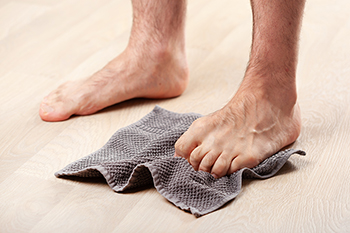
Many people endure foot problems at some point in their lives. A foot injury may have caused the foot to become lethargic and performing specific exercises may help to get strength and movement back. This can promote accelerated tissue healing and can help to gradually return to normal activities. When starting a new exercise regime after a foot injury it is important to pay attention to different levels of pain that may exist. If the pain increases, it is advised to reduce the number of repetitions and to decrease the speed of the motion. Additionally, it can help to increase resting times between sets to give the affected foot ample time to recharge. Many patients prefer stretching exercises which can help improve range of motion. As soon as a gentle stretch is felt it is advised to hold it for approximately 20 seconds. Movement exercises can build strength and agility and they are performed in repetitions of eight, followed by a brief resting period, and then repeating. If you would like more information about the benefits exercise can have on the feet, please consult with a podiatrist who can answer any questions you may have.
Exercising your feet regularly with the proper foot wear is a great way to prevent injuries and build strength. If you have any concerns about your feet, contact one of our podiatrists from Westside Podiatry Center, LLP. Our doctors can provide the care you need to keep you pain-free and on your feet.
Exercise for Your Feet
Exercise for your feet can help you gain strength, mobility and flexibility in your feet. They say that strengthening your feet can be just as rewarding as strengthening another part of the body. Your feet are very important, and we often forget about them in our daily tasks. But it is because of our feet that are we able to get going and do what we need to. For those of us fortunate enough to not have any foot problems, it is an important gesture to take care of them to ensure good health in the long run.
Some foot health exercises can include ankle pumps, tip-toeing, toe rises, lifting off the floor doing reps and sets, and flexing the toes. It is best to speak with Our doctors to determine an appropriate regimen for your needs. Everyone’s needs and bodies are different, and the activities required to maintain strength in the feet vary from individual to individual.
Once you get into a routine of doing regular exercise, you may notice a difference in your feet and how strong they may become.
If you have any questions please feel free to contact one of our offices located in Liverpool, Camillus, Skaneateles, Oswego, and Cicero, NY . We offer the newest diagnostic and treatment technologies for all your foot and ankle needs.
Do Your Child's Feet Hurt?
More...
Ankle Pain That Is Not From an Injury

If your ankle hurts and you cannot recall doing anything that might have caused it, it could be a result of a type of arthritis, an autoimmune condition, or an infection. Obviously, the best treatment will depend on the root cause of the pain. Osteoarthritis is when the cartilage cushion between two bones gradually wears away, causing the bones to rub against each other. This might be painful, particularly upon arising, and it can come on suddenly. Rheumatoid arthritis is a chronic autoimmune disease when your body’s immune system begins attacking healthy tissue, including the lining of your ankle joints. This type of arthritis also causes pain, in addition to swelling and stiffness that begin in the toes and move toward the ankles. Fallen arches are when the tendons supporting the arches of the feet get damaged, the arches lose support and fall. An infection starting in a different part of your body may settle in the ankle joint. Any one of these ailments can cause ankle pain. If you feel such pain and believe you have not sustained an ankle injury, it is important to consult with a podiatrist for a proper diagnosis and treatment for the underlying cause.
Ankle pain can have many different causes and the pain may potentially be serious. If you have ankle pain, consult with one of our podiatrists from Westside Podiatry Center, LLP. Our doctors will assess your condition and provide you with quality foot and ankle treatment.
Ankle pain is any condition that causes pain in the ankle. Due to the fact that the ankle consists of tendons, muscles, bones, and ligaments, ankle pain can come from a number of different conditions.
Causes
The most common causes of ankle pain include:
- Types of arthritis (rheumatoid, osteoarthritis, and gout)
- Ankle sprains
- Broken ankles
- Achilles tendinitis
- Achilles tendon rupture
- Stress fractures
- Tarsal tunnel syndrome
- Plantar fasciitis
Symptoms
Symptoms of ankle injury vary based upon the condition. Pain may include general pain and discomfort, swelling, aching, redness, bruising, burning or stabbing sensations, and/or loss of sensation.
Diagnosis
Due to the wide variety of potential causes of ankle pain, podiatrists will utilize a number of different methods to properly diagnose ankle pain. This can include asking for personal and family medical histories and of any recent injuries. Further diagnosis may include sensation tests, a physical examination, and potentially x-rays or other imaging tests.
Treatment
Just as the range of causes varies widely, so do treatments. Some more common treatments are rest, ice packs, keeping pressure off the foot, orthotics and braces, medication for inflammation and pain, and surgery.
If you have any questions, please feel free to contact one of our offices located in Liverpool, Camillus, Skaneateles, Oswego, and Cicero, NY . We offer the newest diagnostic and treatment technologies for all your foot care needs.
How Do Bunions Form?
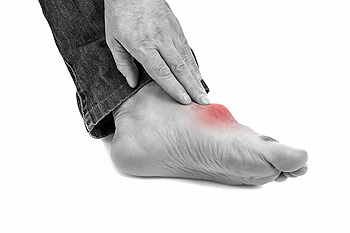 Bunions can arise for a number of different reasons. Some factors that may lead to one getting a bunion include inheriting a bunion tendency, commonly wearing ill-fitting shoes such as high heels, and having rheumatoid arthritis. Other reasons may include birth deformities as well as foot stresses or injuries. A bulging, bony bump on the base of the big toe is a key indicator that you might have a bunion. Along with having a bony bump, swelling, redness, and soreness are additional symptoms that may come with this foot condition. Corns or calluses may also form due to the toes rubbing against each other. If you are experiencing continuous foot pain or decreased mobility of your big toe, we recommend you meet with a podiatrist for a proper diagnosis and advised treatment plan.
Bunions can arise for a number of different reasons. Some factors that may lead to one getting a bunion include inheriting a bunion tendency, commonly wearing ill-fitting shoes such as high heels, and having rheumatoid arthritis. Other reasons may include birth deformities as well as foot stresses or injuries. A bulging, bony bump on the base of the big toe is a key indicator that you might have a bunion. Along with having a bony bump, swelling, redness, and soreness are additional symptoms that may come with this foot condition. Corns or calluses may also form due to the toes rubbing against each other. If you are experiencing continuous foot pain or decreased mobility of your big toe, we recommend you meet with a podiatrist for a proper diagnosis and advised treatment plan.
If you are suffering from bunion pain, contact one of our podiatrists of Westside Podiatry Center, LLP. Our doctors can provide the care you need to keep you pain-free and on your feet.
What Is a Bunion?
Bunions are painful bony bumps that usually develop on the inside of the foot at the joint of the big toe. As the deformity increases over time, it may become painful to walk and wear shoes. Women are more likely to exacerbate existing bunions since they often wear tight, narrow shoes that shift their toes together. Bunion pain can be relieved by wearing wider shoes with enough room for the toes.
Causes
- Genetics – some people inherit feet that are more prone to bunion development
- Inflammatory Conditions - rheumatoid arthritis and polio may cause bunion development
Symptoms
- Redness and inflammation
- Pain and tenderness
- Callus or corns on the bump
- Restricted motion in the big toe
In order to diagnose your bunion, your podiatrist may ask about your medical history, symptoms, and general health. Your doctor might also order an x-ray to take a closer look at your feet. Nonsurgical treatment options include orthotics, padding, icing, changes in footwear, and medication. If nonsurgical treatments don’t alleviate your bunion pain, surgery may be necessary.
If you have any questions, please feel free to contact one of our offices located in Liverpool, Camillus, Skaneateles, Oswego, and Cicero, NY . We offer the newest diagnostic and treatment technologies for all your foot care needs.
Can Wearing High Heels Cause Bunions?
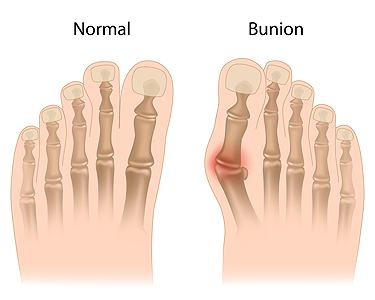 Wearing certain types of high heels may cause a bunion to develop. Additionally, it can come from wearing any type of shoe that has inadequate room for the toes to move freely in. Genetic factors may play a significant role in developing a bunion, in addition to having specific types of medical conditions. It is defined as a large, bony protrusion that gradually forms on the bottom of the big toe, and is considered to be a deformity. Common symptoms that are noticed can include skin that is hard and callused that forms on top of the bunion, and the shape of the foot may appear different. The services of a podiatrist can include an X-ray, which is taken to determine the presence of a bunion, followed by offering correct treatment options, which may include surgery for permanent removal. If you are afflicted with a bunion, it is suggested that you seek the counsel of a podiatrist for proper care.
Wearing certain types of high heels may cause a bunion to develop. Additionally, it can come from wearing any type of shoe that has inadequate room for the toes to move freely in. Genetic factors may play a significant role in developing a bunion, in addition to having specific types of medical conditions. It is defined as a large, bony protrusion that gradually forms on the bottom of the big toe, and is considered to be a deformity. Common symptoms that are noticed can include skin that is hard and callused that forms on top of the bunion, and the shape of the foot may appear different. The services of a podiatrist can include an X-ray, which is taken to determine the presence of a bunion, followed by offering correct treatment options, which may include surgery for permanent removal. If you are afflicted with a bunion, it is suggested that you seek the counsel of a podiatrist for proper care.
If you are suffering from bunions, contact one of our podiatrists of Westside Podiatry Center, LLP. Our doctors can provide the care you need to keep you pain-free and on your feet.
What Is a Bunion?
A bunion is formed of swollen tissue or an enlargement of boney growth, usually located at the base joint of the toe that connects to the foot. The swelling occurs due to the bones in the big toe shifting inward, which impacts the other toes of the foot. This causes the area around the base of the big toe to become inflamed and painful.
Why Do Bunions Form?
Genetics – Susceptibility to bunions are often hereditary
Stress on the feet – Poorly fitted and uncomfortable footwear that places stress on feet, such as heels, can worsen existing bunions
How Are Bunions Diagnosed?
Doctors often perform two tests – blood tests and x-rays – when trying to diagnose bunions, especially in the early stages of development. Blood tests help determine if the foot pain is being caused by something else, such as arthritis, while x-rays provide a clear picture of your bone structure to your doctor.
How Are Bunions Treated?
- Refrain from wearing heels or similar shoes that cause discomfort
- Select wider shoes that can provide more comfort and reduce pain
- Anti-inflammatory and pain management drugs
- Orthotics or foot inserts
- Surgery
If you have any questions, please feel free to contact one of our offices located in Liverpool, Camillus, Skaneateles, Oswego, and Cicero, NY . We offer the newest diagnostic and treatment technologies for all your foot care needs.
Can You Get Arthritis in Your Feet?
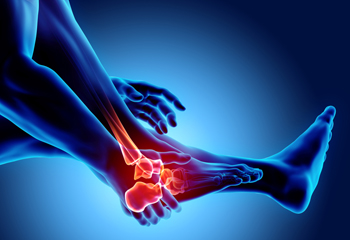 There are multiple types of arthritis that can affect the joints of the feet, including osteoarthritis, rheumatoid arthritis, psoriatic arthritis, and gout. Osteoarthritis is the most common type, affecting millions of people by breaking down the cushioning cartilage between the bones that form the joints. Rheumatoid arthritis, which is less common, is an autoimmune condition that damages the lining of the joints. Psoriatic arthritis can affect people who have a skin condition called psoriasis, while gout is caused by excessive levels of uric acid in the bloodstream. Regardless of the type of arthritis one might have, there is a set of typical arthritis symptoms that affect the feet. These symptoms include joint pain, swelling, and stiffness, as well as a restricted range of motion in the affected joint. If you have arthritis in the joints of your feet, it is suggested that you consult with a podiatrist for treatment.
There are multiple types of arthritis that can affect the joints of the feet, including osteoarthritis, rheumatoid arthritis, psoriatic arthritis, and gout. Osteoarthritis is the most common type, affecting millions of people by breaking down the cushioning cartilage between the bones that form the joints. Rheumatoid arthritis, which is less common, is an autoimmune condition that damages the lining of the joints. Psoriatic arthritis can affect people who have a skin condition called psoriasis, while gout is caused by excessive levels of uric acid in the bloodstream. Regardless of the type of arthritis one might have, there is a set of typical arthritis symptoms that affect the feet. These symptoms include joint pain, swelling, and stiffness, as well as a restricted range of motion in the affected joint. If you have arthritis in the joints of your feet, it is suggested that you consult with a podiatrist for treatment.
Arthritis can be a difficult condition to live with. If you are seeking treatment, contact one of our podiatrists from Westside Podiatry Center, LLP. Our doctors can provide the care you need to keep you pain-free and on your feet.
Arthritic Foot Care
Arthritis is a joint disorder that involves the inflammation of different joints in your body, such as those in your feet. Arthritis is often caused by a degenerative joint disease and causes mild to severe pain in all affected areas. In addition to this, swelling and stiffness in the affected joints can also be a common symptom of arthritis.
In many cases, wearing ill-fitting shoes can worsen the effects and pain of arthritis. Wearing shoes that have a lower heel and extra room can help your feet feel more comfortable. In cases of rheumatoid arthritis, the arch in your foot may become problematic. Buying shoes with proper arch support that contour to your feet can help immensely.
Alleviating Arthritic Pain
- Exercises that stretch the foot can prevent further pain and injury and increase mobility
- Most of the pain can be alleviated with anti-inflammatory drugs, heat, and topical medications
- Massages can help temporarily alleviate pain.
It is best to see your doctor for the treatment that is right for your needs and symptoms. Conditions vary, and a podiatrist can help you determine the right method of care for your feet.
If you have any questions, please feel free to contact one of our offices located in Liverpool, Camillus, Skaneateles, Oswego, and Cicero, NY . We offer the newest diagnostic tools and technology to treat your foot and ankle needs.

